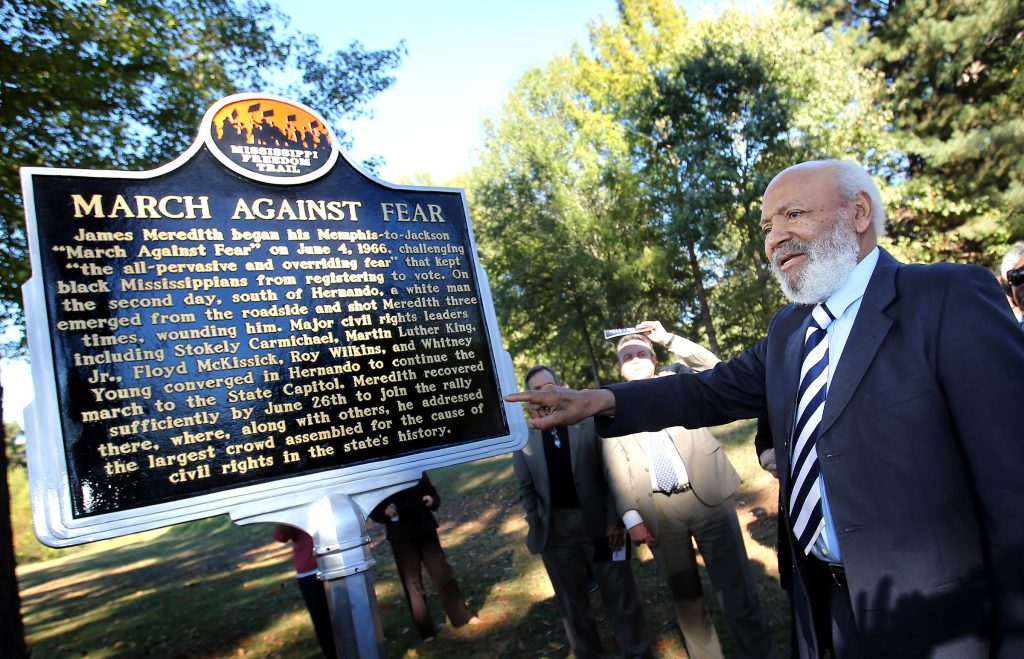In December 2017, the state of Mississippi officially opened the Mississippi Civil Rights Museum as a part of the Two Mississippi Museums. Prior to its opening, there were only brief and carefully selected exhibits from the true history of Black people and Mississippi’s racist past in the Old Capitol Museum. An example of that condition can be seen even now by viewing the Black people selected for inclusion in the state’s hall of fame.
The Mississippi Civil Rights Museum, along with more than sixty Freedom Trail Markers around the state, now do a much better job of exposing the history of racism in the state.
With the backing of groups such as the Mississippi Humanities Council, the state embarked upon a campaign to display significant civil rights events and to highlight major individuals active in advancing civil rights in the state.
The idea also caught on that many individuals who had lost their lives, whether as civil rights activists or just ordinary Black citizens, should be recognized as well in the graphic history on Mississippi.
Together, with the museums such as the Mississippi Civil Rights Museum, the Smith Robertson Museum, the Emmett Till Historic Intrepid Center in Glendora, and the African American Military History Museum in Hattiesburg, the historical markers can go a long way to correct the written record and combat the effort of many white supremacists to hide, distort, or destroy the genuine history of racism and of Black achievements in the state.
This is important because, like right-wing racists around the country, many Republican leaders in the state are dead-set on ridding school curricula of the truths about Black history and American racism. As was done in the Jim Crow era, they desire no teaching nor any textbooks to deal with such matters, and will stop at nothing in achieving their goal.
Museums and historical markers must therefore become tools to educate the children.
While the more comprehensive museums are located in just a few areas, be that Jackson, Hattiesburg, Natchez, or elsewhere, the historical markers are scattered around the state, each dealing with one particular individual, group, or event. This means that persons can travel to one of the few locations where there is a museum or they will need quite a bit of time and money in order to become acquainted with all the historical markers.
The historical markers begin as far north as the Rust College marker in Holly Springs, which was the first college in the state for Black citizens, the marker in DeSoto County where James Meredith was shot on his march against fear, and the Ole Miss marker where a deadly riot broke out over Meredith’s admission.
The markers extend as far south as the marker on Biloxi Beach were Dr. Gilbert Mason led a series of wade-ins against the segregation policy imposed in the 1950s and 60s, and the marker documenting the lynching of Mack Charles Parker and the civil rights movement in Natchez.
Certain movements, such as the Tougaloo, Madison County, Harrison County, McComb, Greenville, Greenwood, and Jackson movements, are recognized by markers.
There are of course markers locating the homes of such civil rights leaders as Dr. T.R.M. Howard, Medgar Evers, Unita Blackwell, Fannie Lou Hamer, and Aaron Henry.
There are markers pinpointing the place where the phrase “Black Power” gained its national prominence.
These and other markers underscore the role of the Black church, a few courageous lawyers and Black plaintiffs, “freedom schools,” and organizations such as the Congress of Federated Organizations, the NAACP, the Masonic lodges and the African Methodist Episcopal Church as a denomination.
The markers which portray the massacres, such as in Clinton and at Jackson State University; those which narrate the murders of Rev. George Lee, Vernon Dahmer, and Wharlest Jackson as well as those which describe lynching, such as Emmett Till, James Chaney, Andrew Goodman, and Michael Schwerner, are generally very comprehensive and direct, not given to sugar-coating.
Again, as a whole, the historical markers and the museum exhibits can do an effective job in combatting the opponents of critical race theory. They are certainly necessary in turning away those who would deny the truth about the state’s past when it comes to Black history and the history of racism in the state.
On the one hand, looking at the two things, museums and historical markers, it can be seen that one can learn quite a bit of history. On the other hand, it is easy to see how much better it would be if students could learn the history in a comprehensive class and then have those lessons supplemented by the exposures to the museums and markers. In too many cases, students pay less attention to things that are not a part of the school curriculum. They, therefore, need the history lessons in the curriculum and exposure to the museums and markers.
Challenges to teaching the history of Black people and the racism of the state in the schools are more likely than not to increase as white supremacists, especially those who are right-wing Republicans, step up their ideological, if not so intellectual war on education. Parents, care-givers, religious teachers, mentors, and other role models need to arm themselves with the true and accurate history of this state and country so that they can off-set or fill in the gaps of what is missing from the education which the students receive at school.
Becoming familiar with the contents of the museums and markers can be one excellent start. It is there for the taking, but it does require the commitment and the effort of those who care and can be of influence.







